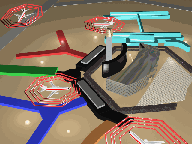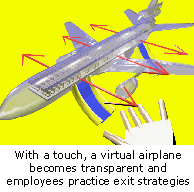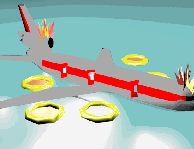|
In the airline industry, superior training brings competitive advantages. While training flight attendants and ground crews, realism becomes particularly important. Virtual reality-based training fosters an exceptional familiarity with aircraft, safety procedures, weather conditions, facilities, and equipment. It is light years beyond any existing training methodology as virtual reality-based airline training programs are closer to real life situations and emergencies than any existing form of training.
Wind sheers can now be seen from a virtual aircraft window. Trainees, with a touch, make an aircraft cabin transparent to see its component parts. Flight attendants are placed in situations such as an emergency landing in the middle of the Atlantic Ocean, or evacuating passengers in a smoke-filled cabin. All of this is done in gritty realism complete with screaming passengers, confusion, and challenges to be overcome. Virtual "risk regions," heat zones, and toxic gas zones allow trainees to see the danger of smoke and other hazards in transparent color.
Airline training in virtual reality need not be confined to a national training center, but can be delivered to employees in individual airports and offices (wherever there's a PC), saving time and money. It combines the power and realism of expensive simulators with the economy of personal computers, providing the airline industry with the world's most sophisticated training at a great price.
|
|



